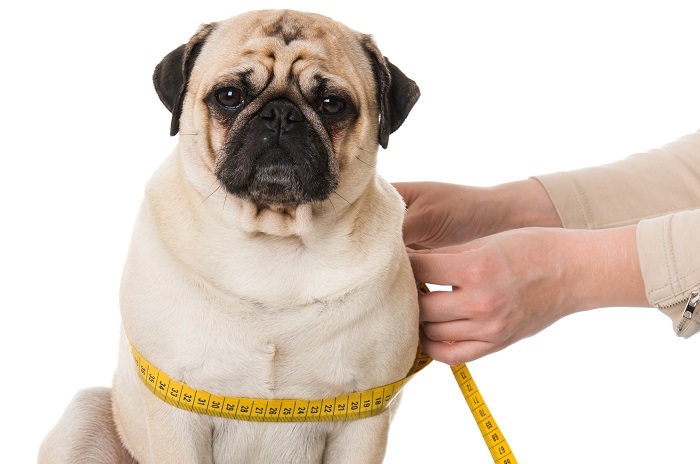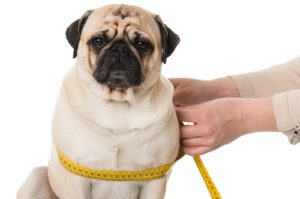Pet Food For Overweight Pets

 Unfortunately, in our store we see a lot of pets that are overweight. Pet parents naturally want to put their pets on a diet. I do not suggest putting your pets on a pet food that is designed for weight loss. The problem is that most of these foods take out specific nutrients they need and add additional fiber. With the thought, fiber will make your pet fill full. Unfortunately, too high fiber and too low fat diets can be an unhealthy diet for your pet.
Unfortunately, in our store we see a lot of pets that are overweight. Pet parents naturally want to put their pets on a diet. I do not suggest putting your pets on a pet food that is designed for weight loss. The problem is that most of these foods take out specific nutrients they need and add additional fiber. With the thought, fiber will make your pet fill full. Unfortunately, too high fiber and too low fat diets can be an unhealthy diet for your pet.Here is an article about pet obesity and pet foods that are “designed” for weight loss.
STORY AT A GLANCE:
- In response to the epidemic of pet obesity, pet food companies are focused on “weight loss” formulas loaded with fiber, with the goal of making dogs and cats feel full.
- One very popular fiber used in “weight loss” pet foods is powdered cellulose (sawdust); too much of it and other types of unsuitable fiber can interfere with your pet’s ability to digest and assimilate important nutrients.
- Chronic deprivation of nutrients to the cells can result in feelings of constant hunger, an indication your pet isn’t getting enough of the right kind of protein to adequately sustain his biology.
- Dogs and cats do best on small amounts of suitable fiber as part of a nutritionally balanced, species-appropriate diet.
The key to keeping your dog or cat at an ideal weight and nutritionally fit at the cellular level is a high-animal protein, moisture-rich diet fed in controlled portions, and augmented with plenty of physical activity.
By Dr. Karen Shaw Becker
As U.S. pet obesity rates skyrocket (as of 2016, 54 percent of dogs and 59 percent of cats were overweight or obese), processed pet food manufacturers are increasing their focus on “weight loss” formulas. These formulas have always contained loads of fiber, which as we know is biologically inappropriate nutrition for dogs (scavenging carnivores) and cats (obligate carnivores).
Here’s a snapshot of how Big Pet Food views the solution to the epidemic of fat pets:
“I think the main take-home message … is that a diet based on high fiber and high protein seems to have the best effect in limiting voluntary food intake in dogs and cats,” says pet food researcher Alex Wilson, Ph.D., of the University of Liverpool.
“It is common for obese dogs and cats to become hungry during a weight loss regime, and this typically leads to increased ‘food-seeking’ behavior. This can be problematic for owners because they find it difficult to avoid giving extra treats and table scraps, and this can then derail the whole process.”1
The Goal: Fool Pets Into Thinking They’re Full
As you can see, one of the goals of pet food companies is to develop formulas for overweight dogs and cats that create a feeling of fullness or satisfaction, which presumably stops them from seeking more food, which in turn stops their owners from overfeeding them. Put another way, the goal is to stuff carnivorous dogs and cats full of species-inappropriate fiber-rich food so they won’t act hungry, and in turn, their owners won’t overindulge them.
This thinking is so wrong on so many levels I’m not sure where to begin. Let’s just say I’m adamantly opposed to intentionally feeding companion animals biologically inappropriate nutrition so their owners don’t have to deal with begging behavior or the temptation to overfeed their pets.
I’d like to believe most pet parents could find the energy and ambition to feed their dog or cat the nutrition she was designed to eat, in reasonable portions. And hopefully they can also muster the patience to ignore begging (which is learned behavior that can be extinguished with a bit of effort) for the sake of their pet’s health.
One Popular Source of the Fiber in ‘High Fiber’ Weight Loss Pet Food: Powdered Cellulose (Sawdust)
One of the formulas Wilson used in a study of weight loss pet foods2 was Royal Canin’s Satiety Weight Management Canine.3 This food contains 18.8 percent fiber, which is about twice the amount of fiber in your average bag of grain-free dog food.
The first ingredient, meaning the primary ingredient in the formula, is powdered cellulose, which is the source of most of the fiber in this food. Powdered cellulose is actually wood pulp (sawdust), believe it or not. Most of the cellulose used in pet food comes from pine trees.4
Powdered cellulose has a tremendous amount of insoluble fiber, and too much of it can interfere with your pet’s ability to digest and assimilate important nutrients like protein and minerals.
High levels of cellulose can also rob cells in the colon of critical fuel, like butyrate, due to reduced fermentation.5 Excessive powdered cellulose in your pet’s food will also cause him to produce a bigger volume of poop.
If you have an overweight dog or cat, it’s important to recognize that the formulation of most “weight loss” diets for pets is based on a completely flawed premise about the biological requirements of companion animals.
Too much fiber acts as a mechanical barrier, preventing trace minerals, vitamins and antioxidants from getting to and through the walls of your pet’s gastrointestinal (GI) tract.
Fiber may make your pet feel temporarily full, but he’s not being satiated at the all-important cellular level. Your pet’s biological requirement for fiber and carbohydrates (starch) is small, which means when fiber replaces protein in the diet, he can end up obsessively searching for more amino acids.
Chronic deprivation of nutrients to the cells can result in feelings of constant hunger.
This is because your carnivorous dog or cat isn’t getting enough of the right kind of protein to adequately sustain his biology. And if his constant hunger keeps you shoveling more “weight loss” food at him, what you’ll wind up with is a still-fat or even fatter pet who is overfed but undernourished.
Next to water, animal (not plant) protein is the most important nutrient for your dog or cat. Every cell of his body requires protein and when he doesn’t get enough of this essential nutrient, a host of negative side effects can occur.
Healthy Dogs and Cats Thrive on Very Small Amounts of Species-Appropriate Fiber
When thinking about the need for fiber in your dog’s or cat’s diet, it’s important to remember that wild canines and felines have no physiologic requirement for the plant fibers used in most processed pet food.
The fiber wild dogs and cats ingest is primarily derived from the already-digested stomach contents of their prey, plus fur, tendons and ligaments. Although the amount of fiber in the diet of wild dogs and cats is small, it serves a very important role.
Dogs and cats fed processed commercial diets very often benefit from the addition of a small amount of the right kind of fiber, which is fiber that closely mimics the GI contents of small prey animals. However, when your pet consumes unnecessary fillers, like wads of fiber, it inhibits digestion and absorption of many vital nutrients.
In addition, many of these formulas do not contain adequate trace minerals and vitamins to meet a pet’s reduced metabolic energy requirements. Reducing calories (or energy) is one thing, but there still must be a minimum amount of vitamins and minerals for normal biologic processes.
Because most pet food producers don’t add in additional nutrients for their “less active” formulas, and because many people feed below the recommended amount to encourage weight loss, these pets end up being deprived of the necessary vitamins and minerals for overall health and vitality while consuming “diet” food.
A small amount of fiber is very important, but a diet loaded with fiber is very detrimental. If you’re feeding your dog or cata nutritionally balanced, species-appropriate diet with appropriate supplementation, including pet probiotics and digestive enzymes, and she’s easily producing small, firm stools, she’s getting the amount of fiber she needs.
6 Tips for Getting Your Pet’s Weight Under Control
For the sake of your pudgy pooch or flabby feline, I recommend you do the following:
Ignore any pet food marketing ploy aimed at making you believe the newest fiber-filled bag of “weight loss” pet food is the answer to your dog’s or cat’s obesity.
Ignore any pet food marketing scheme that uses human diet buzzwords to convince you the same nutritional principles apply to your pet.
Feed a nutritionally balanced, species-appropriate diet to your pet. Regardless of her weight, your dog or cat still needs the right nutrition for her species, which means food that is high in animal protein and moisture, with low or no grain content.
Calculate how much food your pet needs to reach his ideal body weight. This is probably the most overlooked step in weight loss success.
Practice portion control — typically a morning and evening meal, carefully measured. A high-protein, low-carb diet with the right amount of calories for weight loss, controlled through the portions you feed, is what will take the weight off your dog or cat. And don’t forget to factor in any calories from treats.
Regularly exercise your pet. An overweight body gets back in shape by taking in fewer calories and expending more energy. Daily exercise, including at least 20 minutes of consistent aerobic activity, will help your pet burn fat and increase muscle tone.
The key to getting and keeping your pet lean and healthy can’t be found in the latest bag or can of high-fiber, biologically inappropriate pet food. The key to keeping your dog or cat at a healthy weight and nutritionally fit at the cellular level is a high-animal protein, moisture-rich diet fed in controlled portions, and augmented with plenty of physical activity.
If you would like some assistance if finding the right food for your pet, please come into Beastie Boutique ~ Animal Wellness Center and we will be happy to provide a free consult to assist you with your pet’s needs.
· 3 Royal Canin
Recommended Posts
FEBRUARY IS NATIONAL PET DENTAL HEALTH MONTH
February 03, 2024
National Pet Obesity Awareness Day
October 11, 2023
Vitamin D Deficiency in Cats and Dog
September 01, 2023
